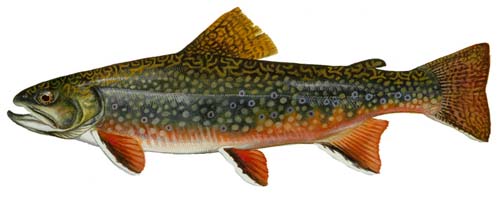The tiger trout is one of the most striking, yet least-encountered trout species in the wild. It is a rare occurring hybrid between a brook trout and brown trout. Most tiger trout exist in the wild as a product of managed stocking programs. If you want to catch a tiger trout you need to fish in locations where they are regularly stocked.
Tiger trout are stocked primarily to support sport fisheries and control rough fish populations. Since they are steril, large numbers can be released into rivers and lakes without becoming a problem themselves. Tiger trout are found in many of the same habitats as brook, brown, and rainbow trout.
Tiger trout are aggressive feeders. When they’re small they feed on a variety of aquatic insects. As adults, they feed almost entirely on smaller baitfish. As piscivorous feeders (they eat other fish), they often grow quite large. Tigers between 2 and 5 pounds are common, and they may reach over 20 pounds. They average between 10 and 16 inches in length, but can grow up to 20 inches.

Habitat: Pond, River, Stream
How to identify Tiger Trout
While the tiger trout is a hybrid between a brook and brown trout, it does not substantially resemble either of its parents. The most distinguishing characteristic of the tiger trout is the unique tiger-like markings that cover its back and sides. Its underlying color is brown along the back with golden yellow to orange coloration along the sides.
Tiger trout often exhibit yellow vermiculation along the sides and back somewhat similar to that of brook trout—but much more vivid. However, tiger trout lack the iconic blue halo spots found on most adult brook trout. Their tanish-brown background coloring is more like that of a brown trout. Where their relationship to brown trout is noticeable is in their large size and voracious appetite.
It’s safe to say that tiger trout look more like brookies, but have a personality more reminiscent of a brown.
Where to catch Tiger Trout
In theory, you should be able to find tiger trout anywhere there are large populations of brook and brown trout residing together. However, unlike other hybrid species, such as cutbows, tiger trout hybrids aren’t nearly as easy to reproduce in the wild. Scientists use a specialized technique known as heat shocking to successfully create tiger trout in a controlled environment.

Tiger trout are found in many of the same habitats as brook, brown, and rainbow trout, but they are usually placed in these habitats through managed stocking programs. Arizona, Arkansas, Colorado, Connecticut, Georgia, Idaho, Pennsylvania, Washington, West Virginia, Wyoming, Utah, Virginia, Oregon, and Massachusetts are the 14 states that have managed stocking programs for tiger trout.
The following are habitats where you can catch Tiger Trout:
- Current Edges
- Outside of Bends
- Overhanging Trees and Bushes
- Rivers and Streams
- Rock and Boulder Pockets
- Small Pointed Waves
- Undercut Banks
How to catch Tiger Trout
Catching tiger trout isn’t any more complicated than fishing for any other trout species. Some anglers would argue that tiger trout are even easier to catch due to their aggressive nature. The hardest part of catching tiger trout is finding them. Tigers can be taken using light spinning gear or fly tackle.
Similar to other trout species, youngling tigers feed on a variety of aquatic insects. At this stage they’ll take a variety of nymphs and dry flies. Beadheads nymphs are particurly productive for fishing young tiger trout and they’ll take just about any generic dry fly as long as you “match the hatch.”
As they mature and put on some size, tigers begin to feed more at the surface and dry fly fishing becomes more effective. However, many start to feed on larger prey such as baitfish. When tiger trout begin targeting baitfish as their main food source, it’s time to start fishing streamers.
Fishing tiger trout with streamers is pretty straight forward, so don’t over complicate it with fancy presentations or lures. A few simple woolly bugger, leech, sculpin, and nymph patterns is all you need to reel in tigers all day long.
Tiger trout can be caught from shore or boat. When shore fishing, the best time to target these fish is early morning or late afternoon as they scour the cool water shallows in search of prey. When fishing from boat trolling is an effective method.
For fishing streamers and nymph patterns subsurface, use a sinking tip or fly line. If tigers are feeding at the surface, use a floating line with a dry fly or emerger.
The following are effective fishing methods and techniques for catching Tiger Trout:
Best Lures, Bait & Tackle to catch Tiger Trout
Tiger trout are most commonly fished using nymphs, dry flies and streamers. But they can also be taken using spoons, spinners, and bait. If you want to exclusively target larger tigers, use large animated flies that will attract their attention.
The following are a few lures, tackle and baits that can be used to catch tiger trout.



